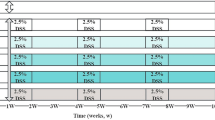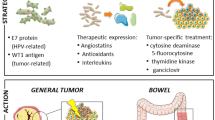Summary
Colon cancer is the third most malignant neoplasm in the world and it remains today an important cause of death, especially in western countries. In this study, we have evaluated the chemopreventive efficacy of morin on tissue lipid peroxidation and antioxidant status, which are used as biomarkers in 1,2-dimethylhydrazine-induced colon carcinogenesis in a rat model. Male Wistar rats were divided into four groups and received high fat diet. Group 1 served as control, groups 2 and 4 were given a daily treatment of morin (50 mg/kg body weight) orally, everyday for a total period of 30 weeks. Groups 3 and 4 were given weekly subcutaneous injections of DMH at a dose of 20 mg/kg body weight in the groin for 15 weeks. Animals were sacrificed at the end of 30 weeks. The liver, intestine, colon and caecum from different groups were subjected to histopathological studies, determination of lipid peroxidation and antioxidant status. Our results showed decreased levels of liver enzymic and non-enzymic antioxidants and increased levels of lipid peroxidation (LPO) products such as tissue thiobarbituricacid substances (TBARS), lipid hydroperoxides (LOOH) and conjugated dienes (CD) in DMH treated rats, which were significantly (P < 0.05) reversed on morin supplementation. Moreover, intestinal, colonic and caecal TBARS, LOOH, CD and also the antioxidants superoxide dismutase (SOD), catalase (CAT), glutathione S-transferase (GST), glutathione peroxidase (GPx), glutathione reductase (GR) and reduced glutathione (GSH) were significantly diminished in DMH treated rats, which were significantly (P < 0.05) elevated on simultaneous morin supplementation. Moreover, enhanced activity of intestinal, colonic and caecal ascorbic acid and α-tocopherol levels were also observed in DMH alone treated rats, which were significantly (P < 0.05) reduced on morin supplementation. These results indicate that morin could exert a significant chemopreventive effect on colon carcinogenesis induced by DMH.







Similar content being viewed by others
References
World Health Organization (WHO) (1997) The world health report. WHO, Geneva
Weisburger JH (1991) Nutritional approach to cancer prevention with emphasis on vitamins, antioxidants and carotenoids. Am J Clin Nutr 53:226S–237S
Ohno K, Narnshima S, Takeuchi S, Itoh K, Itoh T, Hioki K, Nomura T (2001) Effect of bacterial metabolism in the intestine on colorectal tumors induced by 1,2-dimethylhydrazine in transgenic mice harboring human prototype C-Ha-ras genes. J Exp Clin Can Res 20:51–56
Fiala E (1975) Investigations into the metabolism and mode of action of the colon carcinogen 1,2-dimethylhydrazine. Cancer 36:2407–2412
Wiseman H, Halliwell B (1996) Damage to DNA by reactive oxygen and nitrogen species: role in inflammatory disease and progression to cancer. Biochem J 313:17–29
DiGiovanni J (1990) Inhibition of chemical carcinogenesis, chemical carcinogenesis and mutagenisis II. Springer, Berlin, pp 159–202
Middleton E, Kandaswami C (1994) The impact of plant flavonoids on mammalian biology:implications for immunity, inflammation and cancer. The flavonoids: advances in research. Chapman and Hall, London, pp 619–652
Hollman PCH, Katan MB (1997) Absorption, metabolism and health effects of dietary flavonoids in man. Biomed Pharmacother 51:305–310
Kandaswami C, Middleton E (1994) Free radical scavenging and antioxidant activity of plant flavonoids. Adv Exp Med Biol 366:351–376
Fraga CG, Martino VS, Ferraro GE, Coussio JD, Boveris A (1987) Flavonoids as antioxidants evaluated by in vitro and in situ liver chemiluminescence. Biochem Pharmacol 36:717–720
Sengottuvelan M, Viswanathan P, Nalini N (2006) Chemopreventive effect of trans-resveratrol—a phytoalexin against colonic aberrant crypt foci and cell proliferation in 1,2-dimethylhydrazine induced colon carcinogenesis. Carcinogenesis 5:1038–1046
Kamaleeswari M, Nalini N (2006) Dose response efficacy of Caraway (Carum carvi L.) on tissue lipid peroxidation and antioxidant profile in rat colon carcinogenesis. J Pharm Pharmacol 58:1121–1130
Hanasaki Y, Ogawaa S, Fukui S (1994) The correlation between active oxygen scavenging and antioxidative effects of flavonoids. Free Radic Biol Med 16:845–850
Francis AR, Shetty TK, Bhattacharya RK (1989) Modifying role of dietary factors on the mutagenicity of aflatoxin B1: in vitro effect of plant flavonoids. Mutat Res 222:303–401
Denda A, Ura H, Tsujiuchi T, Tsutsumi M, Eimoto H, Takashima Y, Kitazawa S, Kinugasa T, Konishi Y (1989) Possible involvement of arachidonic acid metabolism in phenobarbital promotion of hepatocarcinogenesis. Carcinogenesis 10:1929–1935
Yugarani T, Tan BKH, Teh M, Das NP (1992) Effects of polyphenolic natural products on the lipid profile of rats fed high fat diet. Lipids 27:181–186
Ohkawa H, Ohisi N, Yagi K (1979) Assay for lipid peroxides in animal tissues by thiobarbituric acid reaction. Anal Biochem 95:351–358
Rao KS, Recknagel RO (1968) Early onset of lipid peroxidation in rat liver after carbon tetrachloride administration. Exp Mol Pathol 9:271–278
Jiang ZY, Hunt JV, Wolff SP (1992) Ferrous ion oxidation in the presence of xylenol orange for detection of lipid hydroperoxides in low density lipoprotein. Anal Biochem 202:384–389
Kakkar PS, Das B, Viswanathan PN (1984) A modified spectrophotometric assay of superoxide dismutase. Ind J Biochem Biophys 21:130–132
Sinha KA (1972) Colorimetric assay of catalase. Anal Biochem 47:389–394
Ellman GL (1959) Tissue sulphydryl groups. Arch Biochem Biophys 82:72–77
Carlberg I, Mannervik B (1985) Glutathione reductase. Methods in enzymology 7. Academic, New York, pp 484–490
Rotruck JT, Pope AL, Ganther HE, Swanson AB, Hafeman DG, Hoekstra WG (1973) Selenium: biochemical role as a component of glutathione peroxidase. Science 179:588–590
Habig WH, Pabst MJ, Jakoby WB (1974) Glutathione-S-transferases, the first enzymatic step in mercapturic acid formation. J Biol Chem 249:7130–7139
Roe JM, Kuether CA (1943) Detection of ascorbic acid in whole blood, and urine through 2,4-DNPH derivative of dehydroascorbic acid. J Biol Chem 147:399–407
Baker H, Frank O, DeAngelis B, Feingold S (1980) Plasma tocopherol in man at various times after ingesting free or acetylated tocopherol. Nutr Rep Int 21:531–536
Lowry OH, Rosebrough NJ, Farr AL, Randall RJ (1951) Protein measurement with Folin’s phenol reagent. J Biol Chem 193:265–275
Cooper HK, Buecheler J, Kleihues P (1978) DNA alkylation in mice with genetically difference susceptibility to 1,2-dimethylhydrazine-induced colon carcinogenesis. Cancer Res 38:3063–3065
Fiala ES (1977) Investigations into the metabolism and mode of action of the colon carcinogens 1,2-dimethylhydrazine and azoxymethane. Cancer 40:2436–2445
Das U (2002) A radical approach to cancer. Med Sci Monit 8:RA79–RA92
Oshima M, Dinchuk JE, Kargman SL, Oshima H, Hancock B, Kwong E, Trzaskos JM, Evans JF, Taketo MM (1996) Suppression of intestinal polyposis in Apc delta716 knockout mice by inhibition of cyclooxygenase 2 (COX-2). Cell 29:803–809
Wu TW, Zeng LH, Wu J, Fung KP (1994) Morin: a wood pigment that protects three types of human cells in the cardiovascular system against oxyradical damage. Biochem Pharmacol 47:1099–1103
Cholbi MR, Paya M, Alcaraz MJ (1991) Inhibitory effects of phenolic compounds on CCl4-induced microsomal lipid peroxidation. Experientia 47:195–199
Kenneth AC (2000) Dietary antioxidants during cancer chemotherapy: impact on chemotherapeutic effectiveness and development of side effects. Nutr Cancer 37:1–18
Bartoli GM, Galeotti T (1979) Growth—related lipid peroxidation in tumor microsomal membranes and mitochondria. Biochem Biophys Acta 574:537–541
Byung Pal YU (1994) Cellular defenses against damage from reactive oxygen species. Physiol Rev 14:139–162
Rajeshkumar NV, Kuttan R (2003) Modulation of carcinogenic response and antioxidant enzymes of rats administered with 1,2-dimethylhydrazine by Picroliv. Cancer Lett 191:137–143
Janssen AM, Bosman CB, Kruidenier L, Griffioxn G, Lamers CB, Van krieken JH, Van de Velde CJ, Verspaget HW (1999) Superoxide dismutases in the human colorectal cancer sequence. J Cancer Res Clin Oncol 125:327–335
Brigelius-Flohe R (1999) Tissue-specific functions of individual glutathione peroxidases. Free Radic Biol Med 27:951–965
Linder MC (1985) Nutrition and cancer prevention, nutritional biochemistry and metabolism with chemical applications. Elsevier, New York, pp 347–368
Sies H (1986) Biochemistry of oxidative stress. Angewandte Chem 25:1058–1071
Navarro J, Obrador E, Carretero J, Petschen I, Avino J, Perez P, Estrela JM (1999) Changes in glutathione status and the antioxidant system in blood and in cancer cells associate with tumor growth in vivo. Free Radic Biol Med 26:410–418
Tanaka T, Kawabata K, Kakumoto M, Makita H, Ushida J, Honjo S, Hara A, Tsuda H, Mori H (1999) Modifying effects of a flavonoid morin on azoxymethane-induced large bowel tumorigenesis in rats. Carcinogenesis 20:1477–1484
Henson DE, Block G, Levine M (1991) Ascorbic acid; biologic functions and relation to cancer. J Natl Cancer Inst 83:547–550
Mehlhorn RJ, Sumida S, Packer L (1989) Tocopheroxyl radical persistence and tocopherol consumption in liposomes and in vitamin E-enriched rat liver mitochondria and microsomes. J Biol Chem 264:13448–13452
Cheeseman KH, Burton GW, Ingold KU, Slater TF (1984) Lipid peroxidation and lipid antioxidants in normal and tumor cells. Toxicol Pathol 12:235–239
Author information
Authors and Affiliations
Corresponding author
Rights and permissions
About this article
Cite this article
Sreedharan, V., Venkatachalam, K.K. & Namasivayam, N. Effect of morin on tissue lipid peroxidation and antioxidant status in 1, 2-dimethylhydrazine induced experimental colon carcinogenesis. Invest New Drugs 27, 21–30 (2009). https://doi.org/10.1007/s10637-008-9136-1
Received:
Accepted:
Published:
Issue Date:
DOI: https://doi.org/10.1007/s10637-008-9136-1




